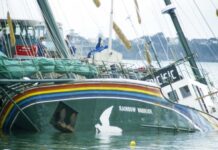Anyone wanting to be reassured that ‘the old Waiheke’ is alive and thriving should spend the next fine Saturday morning at Ostend’s weekly market.
Though versions of farmers’ markets are now fashionable and popular in many centres, this one has been famous on Waiheke – and in a surprising number of other circles – for 40 years. As often as not, it’s been visiting overseas yachties and Auckland friends who have marched me off to the island institution of a Saturday over the years.
It’s an open-air gathering spot to find wholesome food and the people growing or making it, stock up a whole series of books by a favourite author, buy trees grown from locally-sourced seed, catch up on political concerns and spot long-lost friends.
A $15 stall fee gives activists a neutral forum for local concerns, from 1980s peace walkers to marinas, marine reserves and plastic-bag free shopping. You’ll also frequently find local and central government politicians in semi-informal mode here.
It has also spawned a raft of local business that have gone large around the country and it has provided opportunities for the island’s school students, over decades, to develop entrepreneurial schemes to fund their ambitions.
Fortunately, even as Ostend’s shopping precinct burgeons around the market’s location by the War Memorial Hall and RSA headquarters, the island icon is not going anywhere but up in any foreseeable future.
Organisers are now coming to the end of a carefully designed process of developing a strategy for the market’s future, both recording its successful distinctiveness and putting together robust structures to build on its 30-year success under the management of the Waiheke Community Childcare Centre.
I’m there on a sunny Saturday. Long-time market organiser Penny Holmes has gathered up the carefully recorded fees from the stallholders, sorted out someone’s urgent need for change and dropped down into one of the chairs around a usefully-bare table that’s been recently-designated as a general stopping point.
Joe Harrop, chairman of the Waiheke Community Childcare Centre’s committee, joins us with coffees. Later, it will turn out that these lids aren’t recyclable and he and the market’s “eternally vigilant” recycling ambassador Dorothy Fitzgerald will have to separate them out to go into the miniscule bag behind the recycling station that will go to landfill.
It’s midwinter but around us the carnival colours and a slow-moving throng of leisurely browsers make it a time and place to live the lifestyle that travellers around the globe find so enviable.
A timely grant from the Waiheke Local Board enabled the committee to inventory the successes.
“Looking at the market through a regenerative lens, we recognised that the market is part of a rich set of relationships and dynamics that extend well beyond the Ostend hall,” says Joe, quoting the stallholders’ meeting that concluded that the source of its potential lay in its relationship to the larger systems – the Putiki precinct, Waiheke artisan businesses in all their diversity and the community at large.
“A healthy, connected Waiheke community and creative, artisan sector will nourish the market in return.”
Not, he emphasises, that there is anything broken. “The market supports the unique qualities of Waiheke: it nurtures our vibrancy and quirkiness, provides a neutral forum for political viewpoints and, as an intergenerational meeting point, connects the isolated and brings in the young ones.”
A showcase of Waiheke as a foodie destination, it has also, he says, been a launchpad, testing ground and fertile incubator of generations of artisan foods and small businesses.
Local honey, the island’s iconic tamarind chutney and Wendy Kendall’s herb spreads grew from small beginnings here, youngsters sell everything from table grapes from the family vineyard to seasonal plums. Currently a brisk trade has opened up with school students selling hand-made ‘slime’.
Historically, generations of impecunious pony club riders funded their horse gear with lucrative pony rides for which preparation started in the dawn. In the same tradition, while we sit, one of Joe’s offspring reports back at intervals as he trades his way round the stalls, his initial investment increasing with every exchange.
“It’s a place of relationships and connections. Sometimes it feels like being in India,” says Penny, who admits she’s tried to leave the island many times but always finds herself drawn back, not least to the Waiheke market.
“Even when it’s cold and wet, I want to come. For these people, it’s their livelihood. There is a tenacity: the women who knit things, make things, Bill Lord with his one arm, Dulcie with her eggs. . .
Recently, a marketgoer was obviously desperate for breakfast. “Someone turned up a few minutes later with a langos from the stall,” she says.
“This is somewhere people come to be who they are.”
Joe says the process of developing a vision of the market into the future has been invaluable.
“In speaking to people outside the day-to-day running, it has been inspiring to see how dearly Waiheke people hold the market,” he says. It is unique in terms of a community and creates an indefinable bond with people of every age and agenda.
The relationship with the adjacent Waiheke RSA which shares the site is evolving, with both working alongside each other to maximise the opportunities of the RSA’s proposed redevelopment of its building.
Countdown, the Waiheke Local Board and Auckland Council were also involved, with winter an obvious area of growth and a raft of initiatives to support students, businesses and innovative startups.
Started in the 1970s and arguably the longest running of its kind in New Zealand, the market itself is a social enterprise financing childcare and, currently, an upgrade of the childcare centre’s Donald Bruce Road facilities required by Auckland Council.
Rosie Walford, creator of the worldwide life and career coaching network Big Stretch, facilitated the series of sessions with stallholders and organisers that “future-proofed” the market into the 21st century with a new website and long-term plans – including outdoor furniture for a ‘soft spaces’ sitting area – to ensure they continue to meet stallholders’ expectations.
“At one level, this is the old fashioned way,” says Penny, who was a founder of the Waiheke Community Childcare organisation in the mid-1980s. “It’s how you know that the old Waiheke is still here.
“That’s who we are. Even though I’ve been here 20 or 30 years, the essence of it hasn’t changed. People come here and are amazed you can just sit around and chat.”
Having worked with children the whole time she has been on the island, the market is like another family, she says. Now, with a new generation of babies coming through, she says the current organisers are just the kaitiaki for the new fraternities and recent arrivals.
Is there any one thing she’d like to see implemented?
“Cover,” she says decidedly, and although long-time stallholders have their own solutions (some of them going back 25 years) it was a priority from the stallholder consultation too.
It made it to the list, as did improving the market’s indoor-outdoor flow between the hall and the outdoor stalls along the Belgium Street frontage.
The current process, Penny says, has become a big vision “but at the same time, we didn’t want to spook the essence.”
• Liz Waters







